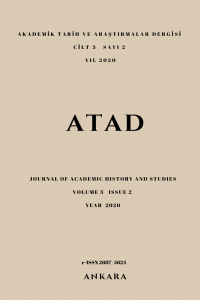Abstract
Bu çalışma İngiltere´nin kolonilerinden birisi olan Burma´da 1930-1932 yıllarında gerçekleşen Saya San isyanını ele almaktadır. Burmalı köylülerin eski bir Budist rahip Saya San öncülüğünde başlattığı isyan Burma´nın bağımsızlığı için gerçekleştirilen en önemli başkaldırı hareketlerinden birisidir. İsyana katılan Burmalı halk ülkelerini sömüren İngilizlere karşı top yekun mücadeleye girişmiş lakin onların düzenli orduları karşısında çaresiz kalmışlardır. Saya San ve takipçileri olan Burma halkı İngilizlerin işgal ile birlikte ortadan kaldırdığı eski Burma krallığını tekrar kurmayı hayal etmiştir. Ayrıca İngilizler tarafından çok ağır bir şekilde sömürülen halk kurtuluşları için tek çarenin bağımsızlık için savaşmak olduğuna inanmıştır. İngilizler ise Hindistan ve Çin arasında stratejik bir konuma sahip olan Burma´ya sahip olmakla önemli bir ticari geçiş noktasını ellerinde tutmaya çabalamışlardır. Ayrıca Burma dünyada tüketilen pirincin yarısından fazlasını üretmesinden dolayı da İngilizlerin önemli gelirler elde ettikleri vazgeçilemez bir ülke olmuştur. Saya San gibi Burma halkını etrafında toplamayı başaran önemli bir liderin İngilizler tarafından isyan tam manası ile tüm ülkeye yayılmadan yakalanması Burmalıların İngilizler karşısında başarısız olmasına sebep olmuştur. Bununla birlikte Saya San isyanı ülke halkının bağımsızlık yolunda göstermiş olduğu mücadelenin bir parçası olarak Burmalılara ümit vermenin yanı sıra Burma tarihinde de önemli bir yere sahip olmuştur.
References
- Adas, Michael, The Burma Delta: The Economic Development and Social Change on an Asian Rice Frontier, 1852-1941, University of Wisconsin Press, London 1974.
- Ashton, S. R., “A rebellion in Burma: The Sagaing Uprising of 1910,” The British Library Journal, Vol. 15, No. 1 (1989), s. 71-89.
- Aung, Htin, A History of Burma, Columbia University Press, New York 1967.
- Aung-Thwin, M., “The British 'Pacification' of Burma: Order without Meaning”, Journal of Southeast Asian Studies , 16:2, (1985), s. 245-261.
- _____, M. “Genealogy of a Rebellion Narrative: Law, Ethnology and Culture in Colonial Burma”, Journal of Southeast Asian Studies 34, 3 (2003), s. 393–419.
- Benda, Harry, J., “Peasant Movements in Colonial Southeast Asia,” Asian Studies, Washington, (1964), s. 420-434.
- Blackburn, T., The British Humiliation of Burma, Orchid Press Books, Bangkok 2000.
- British Library collection of proscribed materials, as catalogued in Shaw & Lloyd: EPP1/47, “Shake to the Earth”, June 1932.
- British Library, India Office Records (BL, IOR), L/PJ/6/2020 correspondence, despatches and telegrams on the Burma Revolt, 1930-1932 Reports, Questions, Letters for Burma up to 1934; L/MIL/5/862 War Diaries of the Burma Rebellion 1930-1932; India Office Select Materials (IOSM) Mss Eur F161/61 Indian Police Collection 1943.
- Brown, Ian, A Colonial Economy in Crisis: Burma’s Rice Cultivators and the World Depression of the 1930s, Routledge Curzon, Oxford 2005.
- Cady, John, A History of Modern Burma, Cornell University Press, Ithaca 1958.
- Clipson, B. Edmund, “Constructing an intelligence state: the development of the colonial security services in Burma 1930-1942”, History, University of Exeter, Phd Thesis, 2010.
- Donnison, F. S. V.,Public Administration in Burma: A Study of the Development during the British Connexion, Royal Institute of International Affairs, London 1953.
- Egreteau, Renaud, “Burma (Maynmar) 1930-2007”, Online Encyclopedia of Mass Violence, 2009, s. 1-14.
- French, Patrick, Liberty or Death, Harper Collins Publishers, London 1997.
- Ghosh, Parimal, Brave Men of the Hills: Resistance and Rebellion in Burma, 1825-1932, Hurst and Company, London 2000.
- Gravers, Mikael, “Questioning Autocratic in Burma: Buddhism between Traditionalism and Modernism” ed. David Westerlund, Questioning the Secular State: The Worldwide Resurgence of Religion in Politics, Hurst & Company, London 1996, s. 297-322.
- Gravers, Mikael, Nationalism as Political Paranoia in Burma, Curzon, Richmond 1999.
- Great Britain, “Report on the Rebellion in Burma up to 3rd May 1931”, House of Commons, Sessional Papers 1930-1931, vol. XII, London 1931.
- Great Britain, “Moral and Material Progress and Condition of India during the year 1930-31”, House of Commons, Sessional Papers 1931-1932, vol. XIX, London 1932.
- Griffiths, Sir Percival, To Guard My People, the History of the Indian Police, Ernest Benn Limited, London 1971.
- Harvey, G. E., British Rule in Burma; 1824-1942, Faber and Faber, London 1946.
- Hays, Jeffrey, “British rule of Burma” Myanmar-History Facts and Details, 2014, s. 1-9.
- Keith, Jeffery, “Intelligence and Counterinsurgency operations: some reflection on the British experience,” Intelligence and National Security, 2, no. 1, 1987.
- Larkin, Emma, “The Self-Conscious Censor Censorship in Burma under the British, 1900–1939”,The Journal of Burma Studies, Volume 8, (2003), s. 64-101.
- Lewy, Guenter, “Militant Buddhist Nationalism: The Case of Burma”,Technical Report, University of Massachusetts, 1967.
- Lintner, Bertil, “The Resistance of the Monks Buddhism and Activism in Burma”, Human Rights Watch, 2009.
- Mang, Pum Za, “Buddhist Nationalism and Burmese Christianity”, Studies in World Christianity, 22.2, (2016), s. 148-167.
- Mendelson, E. M., Sangha and State in Burma. The Study in Monastic Sectarianism and Leadership, Cornell University Press, Ithaca 1975.
- Moscotti, D. Albert, British Policy and the Nationalist Movement in Burma, 1917-1937, University of Hawaii Press, Honolulu 1974.
- Orwell, George, Shooting an Elephant in The Collected Essays, Journalism and Letters of George Orwell: An Age Like This, 1920-1940, eds. Sonia Orwell and Ian Angus, Penguin, London 1970.
- Sakhong, Lian H, In Search of Chin Identity: A Study in Religion, Politics, and Ethnic Identity in Burma, NIAS, Copenhagen 2003.
- Sarkisyanz, Erik, Buddhist Backgrounds of the Burmese Revolution, Nijhoff, Hague 1965.
- Smith, Donald E., Religion and Politics in Burma, Priceton, New Jersey 1965.
- Smith, M., Burma: Insurgency and the Politics of Ethnicity, White Lotus, Bangkok 1999.
- Taylor, H. Robert, The State in Burma, University of Hawaii Press, Honolulu 1987.
- Von der Mehden and Fred R.,Religion and Nationalism in Southeast Asia, University of Wisconsin Press, Madison 1963.
Abstract
References
- Adas, Michael, The Burma Delta: The Economic Development and Social Change on an Asian Rice Frontier, 1852-1941, University of Wisconsin Press, London 1974.
- Ashton, S. R., “A rebellion in Burma: The Sagaing Uprising of 1910,” The British Library Journal, Vol. 15, No. 1 (1989), s. 71-89.
- Aung, Htin, A History of Burma, Columbia University Press, New York 1967.
- Aung-Thwin, M., “The British 'Pacification' of Burma: Order without Meaning”, Journal of Southeast Asian Studies , 16:2, (1985), s. 245-261.
- _____, M. “Genealogy of a Rebellion Narrative: Law, Ethnology and Culture in Colonial Burma”, Journal of Southeast Asian Studies 34, 3 (2003), s. 393–419.
- Benda, Harry, J., “Peasant Movements in Colonial Southeast Asia,” Asian Studies, Washington, (1964), s. 420-434.
- Blackburn, T., The British Humiliation of Burma, Orchid Press Books, Bangkok 2000.
- British Library collection of proscribed materials, as catalogued in Shaw & Lloyd: EPP1/47, “Shake to the Earth”, June 1932.
- British Library, India Office Records (BL, IOR), L/PJ/6/2020 correspondence, despatches and telegrams on the Burma Revolt, 1930-1932 Reports, Questions, Letters for Burma up to 1934; L/MIL/5/862 War Diaries of the Burma Rebellion 1930-1932; India Office Select Materials (IOSM) Mss Eur F161/61 Indian Police Collection 1943.
- Brown, Ian, A Colonial Economy in Crisis: Burma’s Rice Cultivators and the World Depression of the 1930s, Routledge Curzon, Oxford 2005.
- Cady, John, A History of Modern Burma, Cornell University Press, Ithaca 1958.
- Clipson, B. Edmund, “Constructing an intelligence state: the development of the colonial security services in Burma 1930-1942”, History, University of Exeter, Phd Thesis, 2010.
- Donnison, F. S. V.,Public Administration in Burma: A Study of the Development during the British Connexion, Royal Institute of International Affairs, London 1953.
- Egreteau, Renaud, “Burma (Maynmar) 1930-2007”, Online Encyclopedia of Mass Violence, 2009, s. 1-14.
- French, Patrick, Liberty or Death, Harper Collins Publishers, London 1997.
- Ghosh, Parimal, Brave Men of the Hills: Resistance and Rebellion in Burma, 1825-1932, Hurst and Company, London 2000.
- Gravers, Mikael, “Questioning Autocratic in Burma: Buddhism between Traditionalism and Modernism” ed. David Westerlund, Questioning the Secular State: The Worldwide Resurgence of Religion in Politics, Hurst & Company, London 1996, s. 297-322.
- Gravers, Mikael, Nationalism as Political Paranoia in Burma, Curzon, Richmond 1999.
- Great Britain, “Report on the Rebellion in Burma up to 3rd May 1931”, House of Commons, Sessional Papers 1930-1931, vol. XII, London 1931.
- Great Britain, “Moral and Material Progress and Condition of India during the year 1930-31”, House of Commons, Sessional Papers 1931-1932, vol. XIX, London 1932.
- Griffiths, Sir Percival, To Guard My People, the History of the Indian Police, Ernest Benn Limited, London 1971.
- Harvey, G. E., British Rule in Burma; 1824-1942, Faber and Faber, London 1946.
- Hays, Jeffrey, “British rule of Burma” Myanmar-History Facts and Details, 2014, s. 1-9.
- Keith, Jeffery, “Intelligence and Counterinsurgency operations: some reflection on the British experience,” Intelligence and National Security, 2, no. 1, 1987.
- Larkin, Emma, “The Self-Conscious Censor Censorship in Burma under the British, 1900–1939”,The Journal of Burma Studies, Volume 8, (2003), s. 64-101.
- Lewy, Guenter, “Militant Buddhist Nationalism: The Case of Burma”,Technical Report, University of Massachusetts, 1967.
- Lintner, Bertil, “The Resistance of the Monks Buddhism and Activism in Burma”, Human Rights Watch, 2009.
- Mang, Pum Za, “Buddhist Nationalism and Burmese Christianity”, Studies in World Christianity, 22.2, (2016), s. 148-167.
- Mendelson, E. M., Sangha and State in Burma. The Study in Monastic Sectarianism and Leadership, Cornell University Press, Ithaca 1975.
- Moscotti, D. Albert, British Policy and the Nationalist Movement in Burma, 1917-1937, University of Hawaii Press, Honolulu 1974.
- Orwell, George, Shooting an Elephant in The Collected Essays, Journalism and Letters of George Orwell: An Age Like This, 1920-1940, eds. Sonia Orwell and Ian Angus, Penguin, London 1970.
- Sakhong, Lian H, In Search of Chin Identity: A Study in Religion, Politics, and Ethnic Identity in Burma, NIAS, Copenhagen 2003.
- Sarkisyanz, Erik, Buddhist Backgrounds of the Burmese Revolution, Nijhoff, Hague 1965.
- Smith, Donald E., Religion and Politics in Burma, Priceton, New Jersey 1965.
- Smith, M., Burma: Insurgency and the Politics of Ethnicity, White Lotus, Bangkok 1999.
- Taylor, H. Robert, The State in Burma, University of Hawaii Press, Honolulu 1987.
- Von der Mehden and Fred R.,Religion and Nationalism in Southeast Asia, University of Wisconsin Press, Madison 1963.
Details
| Primary Language | Turkish |
|---|---|
| Journal Section | Research Articles |
| Authors | |
| Publication Date | December 30, 2020 |
| Acceptance Date | December 30, 2020 |
| Published in Issue | Year 2020 Volume: 3 Issue: 2 |
Our journal is a member of CrossRef. 


